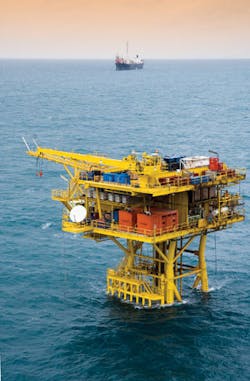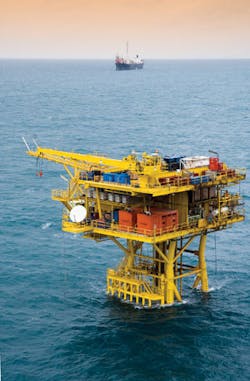Jasmine field to add exploration wells, platforms as production continues
Production currently at 10,000 b/d from 11 wells
Gurdip Singh, Special Correspondent
The Gulf of Thailand’s Jasmine field in exploration block B 5/27 is a major offshore development for Thailand, one of the largest Southeast Asian energy markets, with crude oil consumption over 1 MMb/d.
Jasmine, which began first production in June 2005, is one of many developments underway in the Gulf as the Thai Kingdom seeks ways to boost recovery of indigenous hydrocarbon resources and decrease its dependency on imported oil, especially within the context of current high-cost fuel.
Under a contract with the Petroleum Authority of Thailand (PTT), a domestic refinery has bought all of the 2 MMbbl of Jasmine crude oil pumped by the end of 2005.
At the end of 2005, Jasmine’s production capacity from a single drilling platform and 11 wells was around 10,000 b/d.
Two new drilling platforms will be installed in the field, followed up with six wells, which will increase daily output beginning in early 2007.
The field is situated on the northwestern flank of the Pattani trough, in water depths of 200 ft, producing oil from over 30 separate sandstone reservoirs at depths of 2,600-5,200 ft below sea level.
Jasmine is the most northern oil field in the Gulf and is located some 150 km south of Sattahip. The nearest producing fields are Chevron’s Benchamas and Tantawan oil and gas accumulations, which lie approximately 80 km to the south of Jasmine in block B 8/32.
Pearl Oil (Thailand) Ltd. holds a 100% equity interest and is the operator of the field.
Discovery and development
In 2004, Pearl acquired the Thai assets from London-based Harrods Energy and became the operator of block B 5/27.
Pearl further worked on Harrods’ 16 delineation wells, which had identified 52 significant individual pay zones within dip closed fault blocks. The oil and gas zones were encountered within fluvial sandstones in a Miocene-Oligocene stratigraphic section. Oil flowed to the surface in more than 20 drillstem tests.
Pearl acquired 260 sq km of high-resolution 3D seismic data over block B 5/27 in mid-2004, which was reprocessed with existing data, and together with well logs and engineering test data, was used to pinpoint the location of 12 development wells for the Jasmine A platform.
A fasttrack oil development plan was initiated. The development comprised a wellhead platform, an FPSO vessel, a pipeline-end-manifold (PLEM) system, and support facilities. The wellhead platform design was fit-for-purpose with very little new engineering, which helped fasttrack the project - surface facility construction and installation were completed within 12 months.
Following interpretation of the new 3D seismic data, 12 development wells were drilled from the Jasmine A platform. Development drilling started in April 2005 and took just 75 days to complete at an average rate of 3,488 ft per day with each of the 12 wells hitting its geological targets.
Simultaneously to the development drilling, Pearl Oil ran a five-well exploration program to the north and south of the Jasmine A platform location, with all five wells finding hydrocarbons.
One of the wells reputedly set a record for net oil pay offshore Thailand, intersecting approximately 560 vertical ft of net oil-bearing sandstones, which led to a decision on adding two more platforms, B & C, to the field this year.
Platform B will be located north-northwest of Platform A, and Platform C will be south-southeast of Platform A. About 30 development wells will be drilled from the two platform locations.
Expanding Jasmine E&P
During the planning phase, high resolution 3D seismic data was used together with state-of-the-art full field static and dynamic reservoir modeling studies to provide guidance for reservoir development and management.
The Jasmine A development consists of a single, not normally manned platform connected to a permanently moored FPSO by a 1.8-km pipeline.
The platform has SCADA and can be remotely controlled from the FPSO.
The Jasmine A platform is designed with facilities for production and utilities. The platform is a four-pile jacket with three decks, 16 slots (four vacant slots) with space for a future water injection plant.
All wells are completed as single producers and some wells are installed with electrical submersible pumps (ESPs). Platform power comes from generators installed on the platform. There is a separator for production testing, chemical treatment facilities, utilities and metering. All fluids are recombined after testing and transported via the subsea pipeline to the FPSO for processing.
The two additional platforms under construction will be tied via pipelines to the existing pipeline end manifold (PLEM), which feeds to the FPSO. All of the platforms will have the capability to be remotely controlled.
Jasmine Venture MV7is a tanker-converted FPSO moored in 60 m of water and is capable of processing 30,000 b/d of water and 20,000 b/d of oil. It has a storage capacity of 800,000 bbl.
Gas produced from the field can either be used for fuel, if suitable, or flared/vented.
The FPSO is connected to the PLEM by a single flexible riser. The FPSO has an external turret mooring system with six chains/anchors securing the vessel. It has full 360° weather-vaning capability.
A six-well exploration drilling campaign near the Jasmine field is forthcoming to find additional reserves that can be produced with the existing FPSO.•

